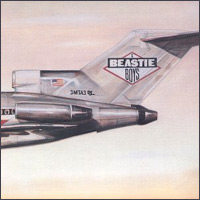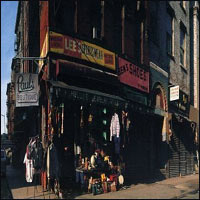 What
exactly are the Beastie
Boys? One could call them rap, but they started out as a hardcore punk act and their
music is decidedly post-modern (read "dripping with irony"). So I'll call them "alternative," 'cause
that can mean virtually anything. That said, the Beasties are one alternative rap act that
hasn't been afraid to change their schtick, enabling them to hold the public's (and my) attention
throughout their career.
What
exactly are the Beastie
Boys? One could call them rap, but they started out as a hardcore punk act and their
music is decidedly post-modern (read "dripping with irony"). So I'll call them "alternative," 'cause
that can mean virtually anything. That said, the Beasties are one alternative rap act that
hasn't been afraid to change their schtick, enabling them to hold the public's (and my) attention
throughout their career.
The spotlight's glare began suddenly for the band with the release of License To Ill,
a sophomoric symphony of heavy metal and rap featuring the anthem "Fight For Your Right
(To Party)." By fusing these two seemingly disparate forms, the Boys tapped into a hidden
vein of suburban culture. Kids had been listening to both - drawn by the shared "outsider" perspective
of both genres - for years. The Beastie Boys simply gave the movement a focal point.
 Then,
to their credit, they took a breather, switched labels, and reinvented themselves,
releasing the sonic pastiche Paul's Boutique. To my ears, it's still their
best album despite worthy successors Check Your Head and Ill Communication, which
consolidated their sound into a more cohesive whole. 1998's Hello Nasty was
another step ahead, incorporating a whole new batch of cultural references, including
retro "electro" leanings, Japanese anime, and Latin beats.
Then,
to their credit, they took a breather, switched labels, and reinvented themselves,
releasing the sonic pastiche Paul's Boutique. To my ears, it's still their
best album despite worthy successors Check Your Head and Ill Communication, which
consolidated their sound into a more cohesive whole. 1998's Hello Nasty was
another step ahead, incorporating a whole new batch of cultural references, including
retro "electro" leanings, Japanese anime, and Latin beats.
With their Grand Royale indie empire, the Beastie Boys are poised to become alt-rap-rock
godfathers, showing the way for a new generation of would-be cultural cuinartists.
The greatest hits package The Sounds Of Science is good, but it leaves off
some great tracks in favor of rarities; Some Old Bullshit compiles material
from the Beasties' punk days (for fanatics only), and The In Sound From Way Out pulls
together various instrumental tracks (some non-LP) from throughout their career.